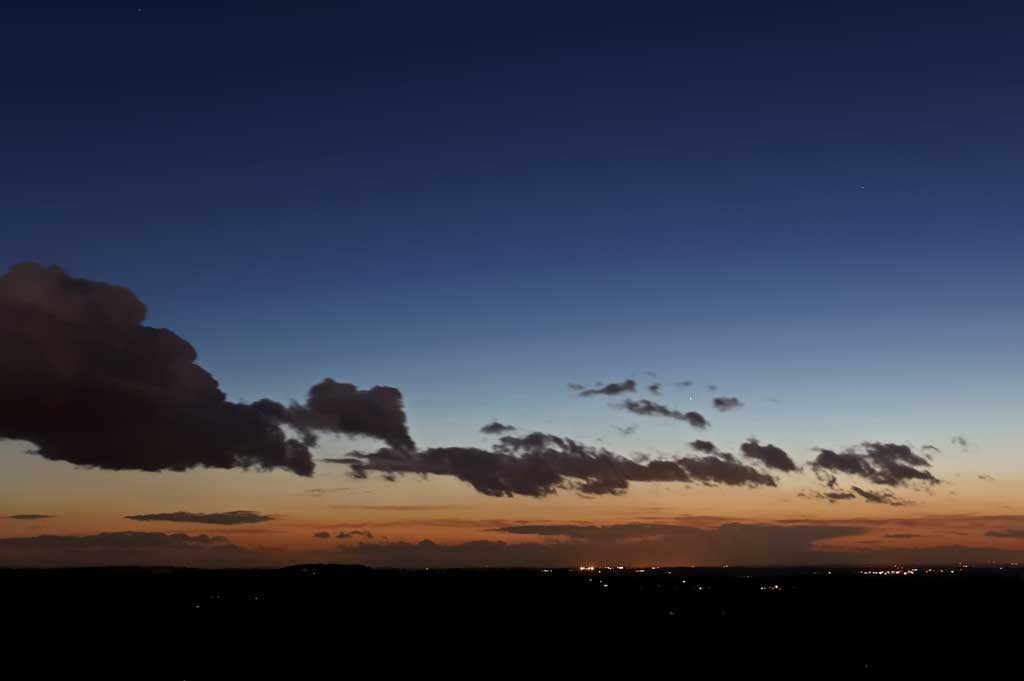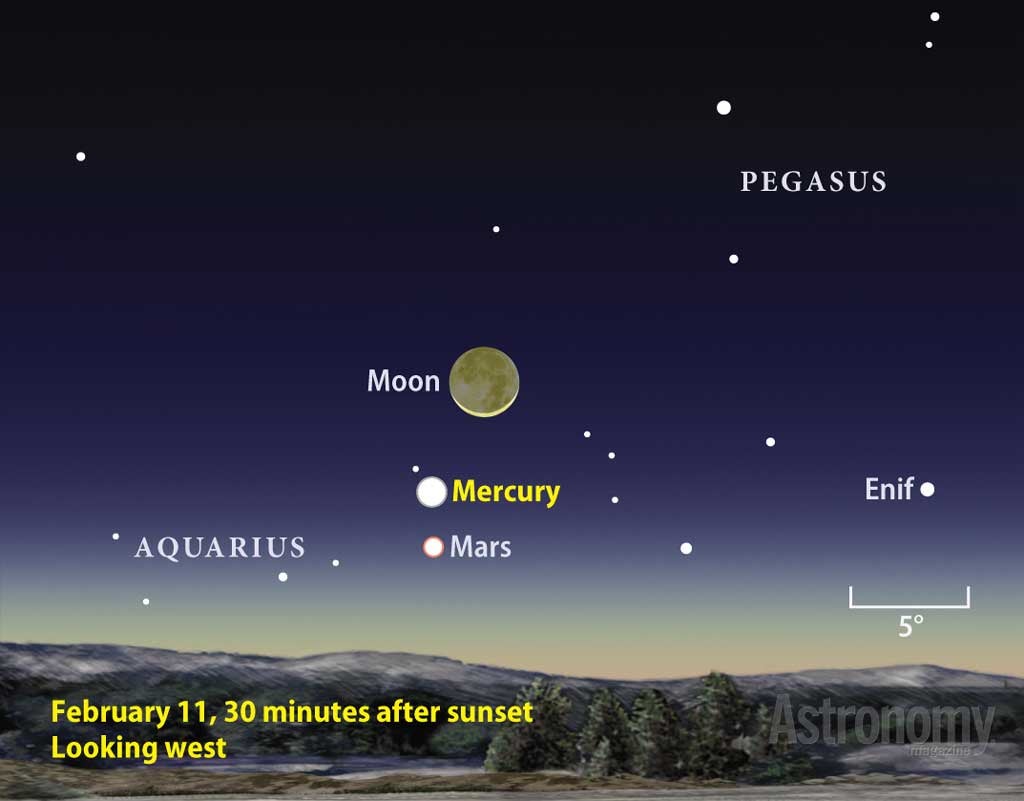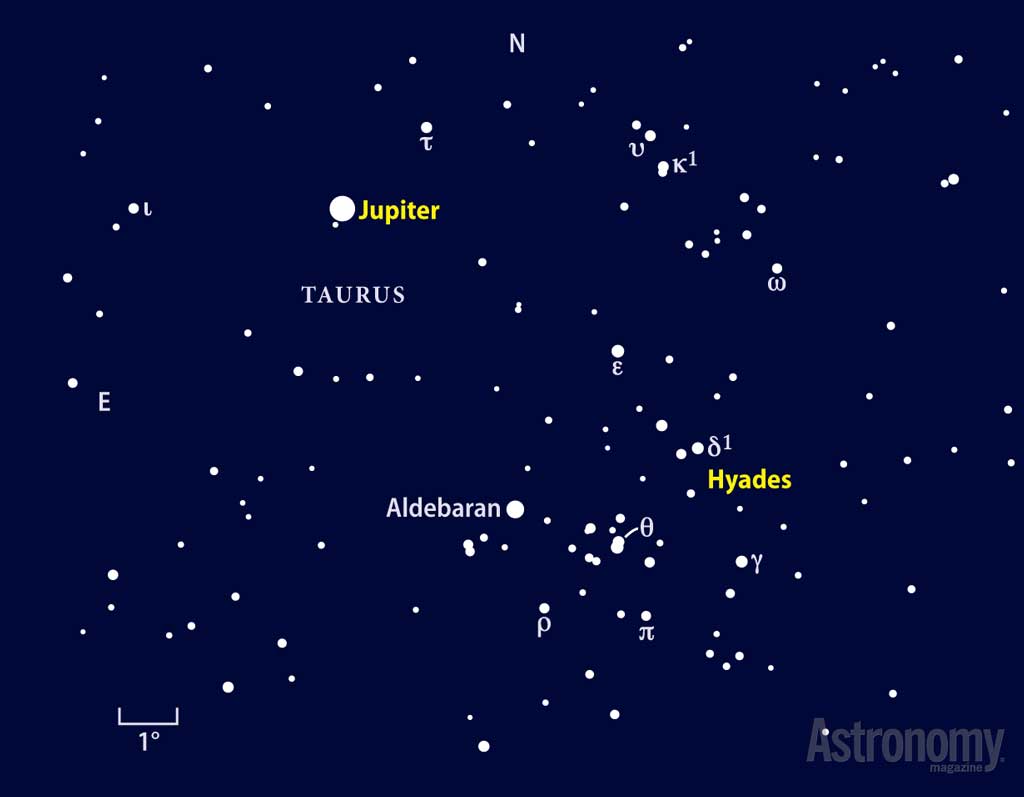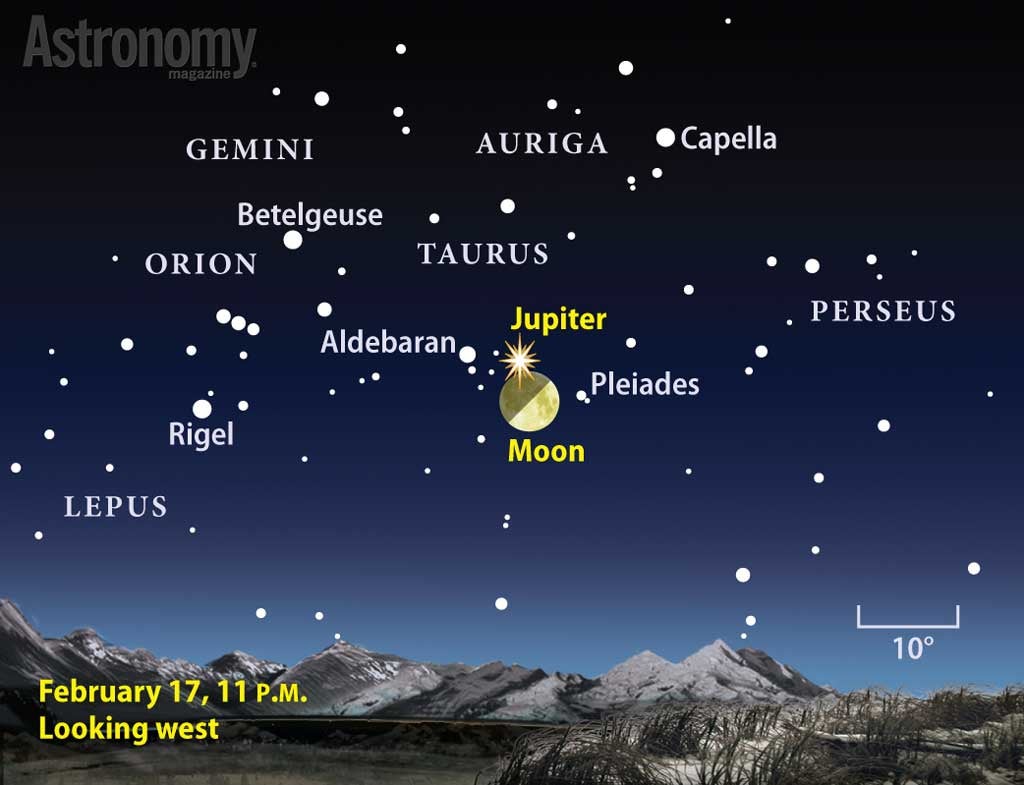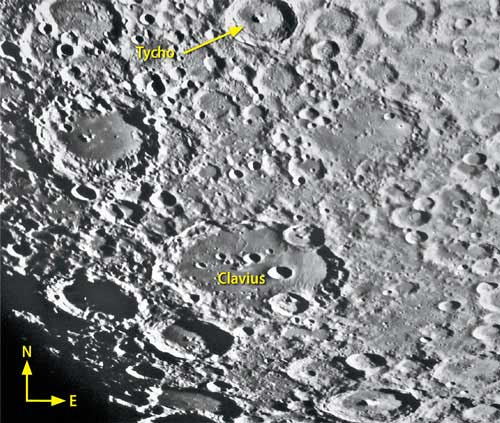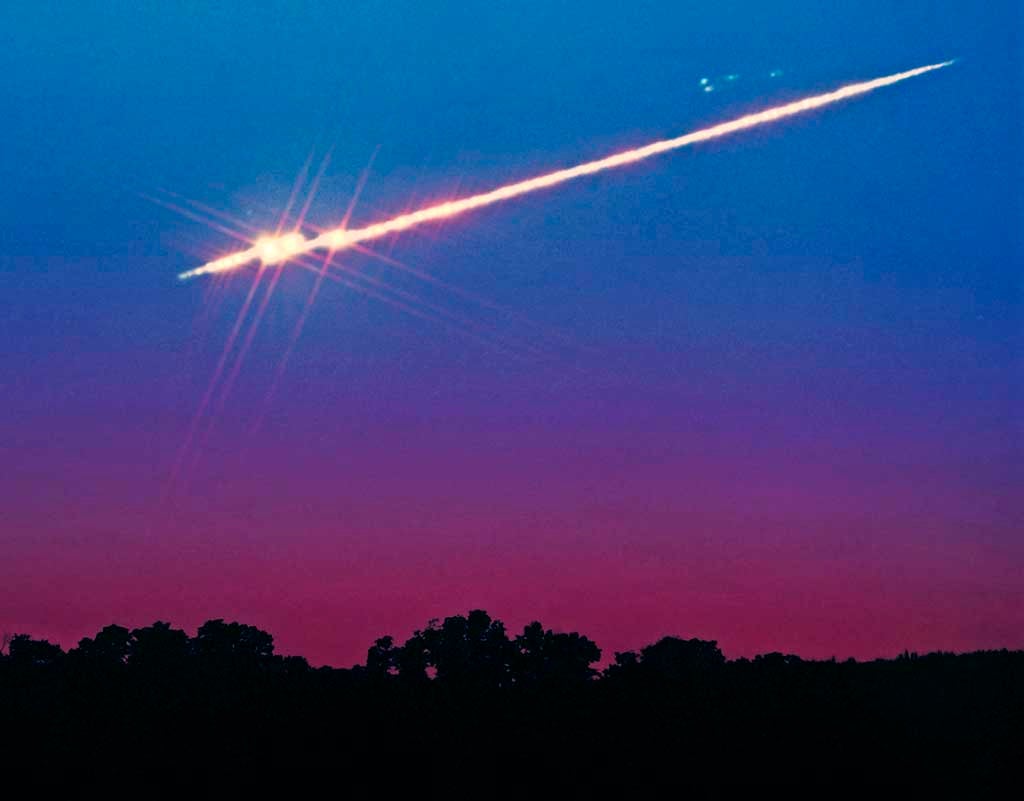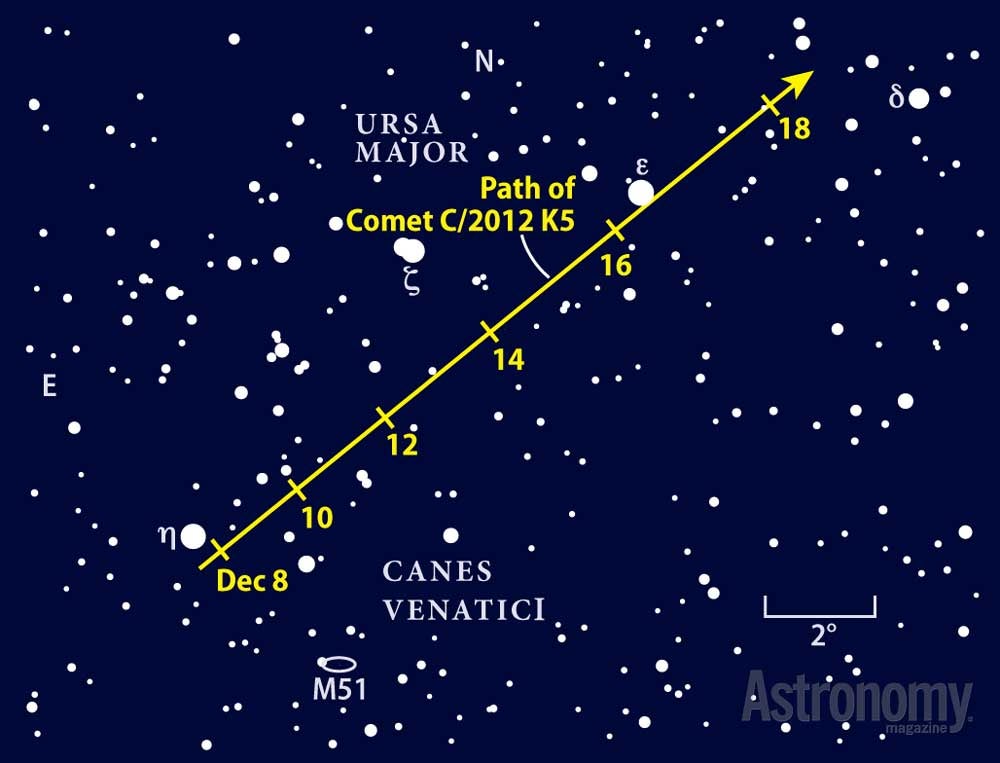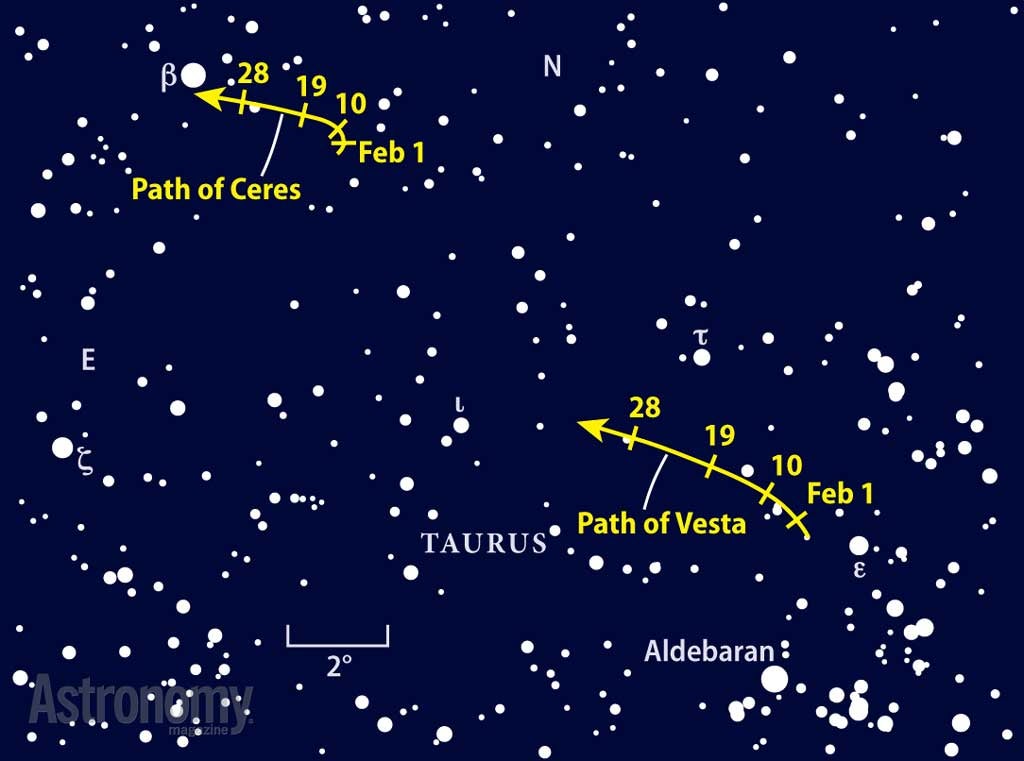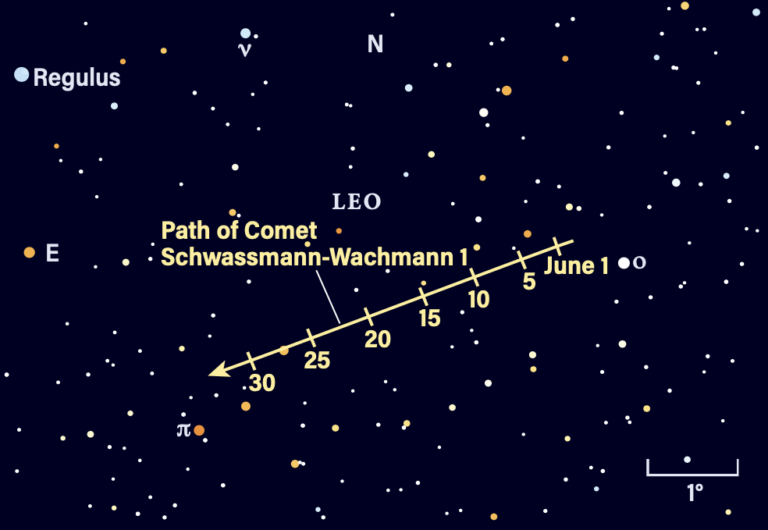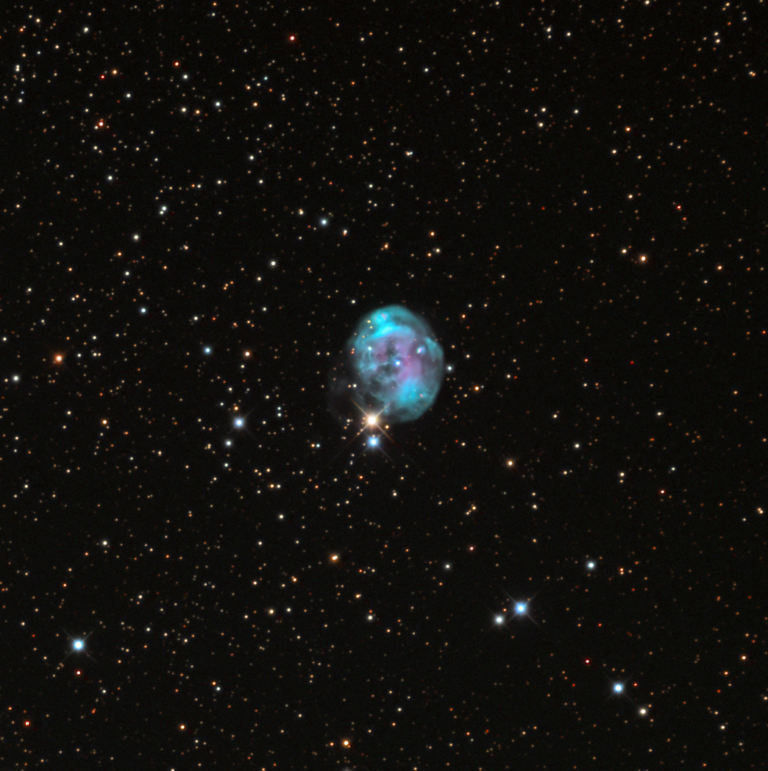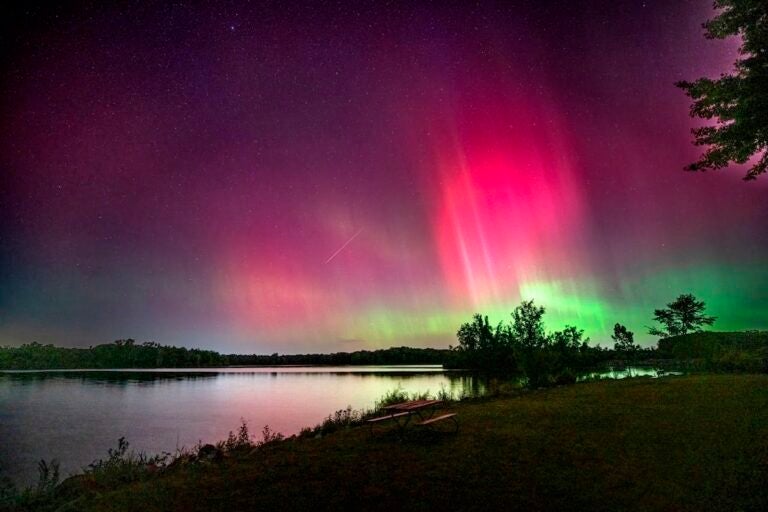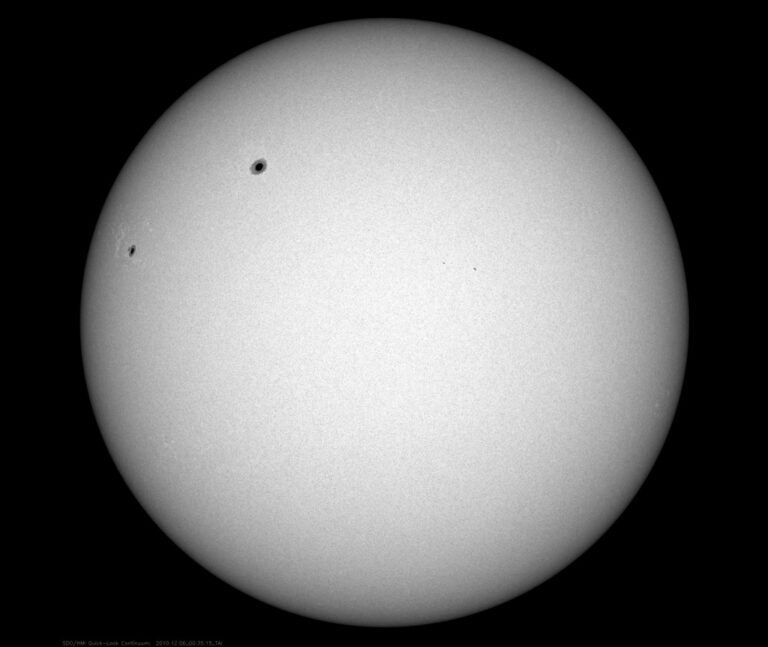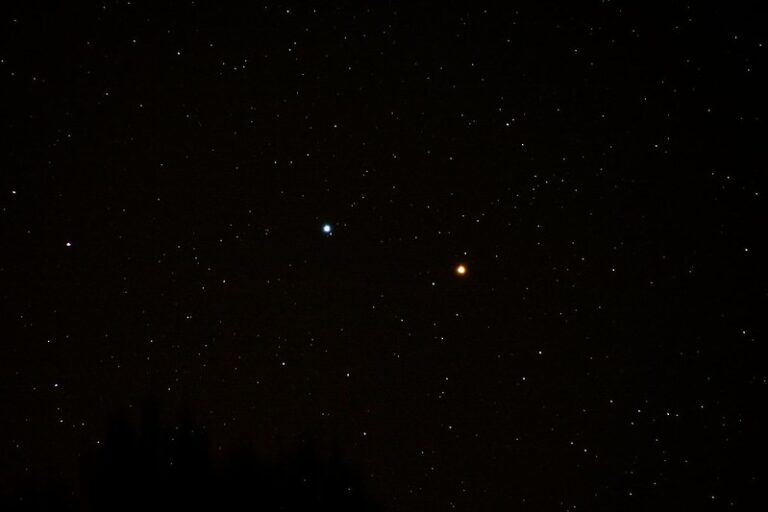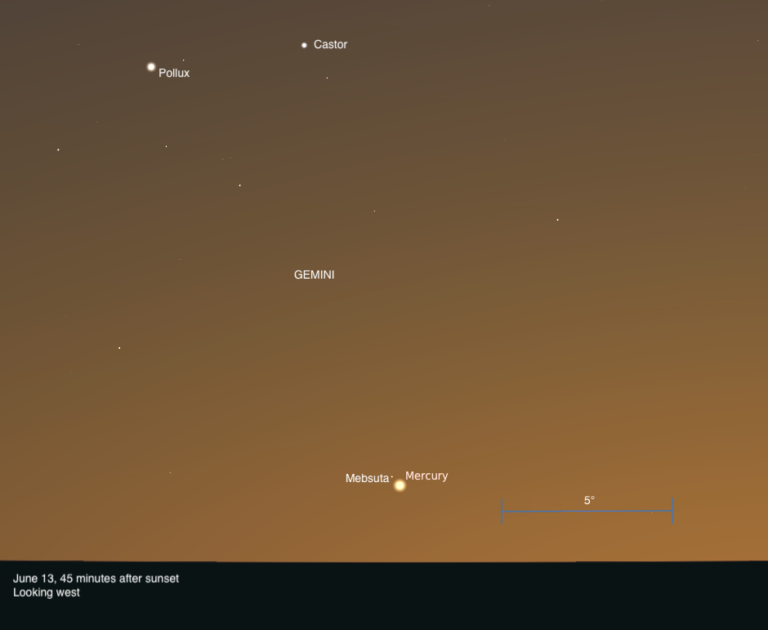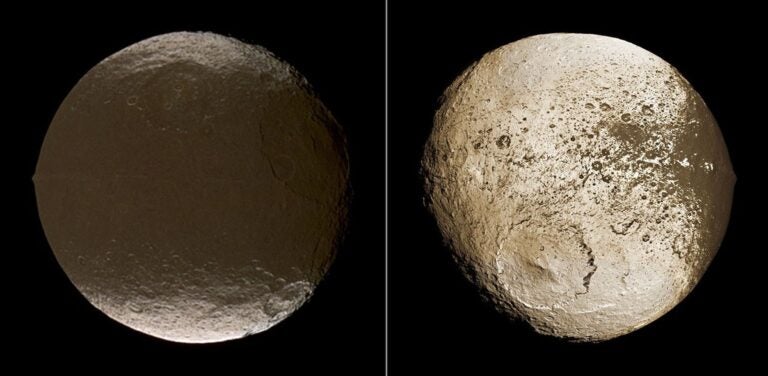We begin our tour low in the western sky shortly after sunset. The deepening twilight offers a pretty background for observers seeking their first glimpse of Mercury during 2013. The innermost planet reached superior conjunction (when it passed on the far side of the Sun from Earth) January 18, and it spends the first two weeks of February climbing higher in the evening sky. On the 1st, Mercury shines brightly at magnitude –1.1 and sets nearly 50 minutes after the Sun. You should be able to spot it through binoculars some 3° high in the west-southwest about a half-hour after sunset.
With each passing day, Mercury appears a little higher and becomes slightly easier to see. Be sure to look February 8, when it passes 0.3° north of Mars. The inner planet then shines at magnitude –1.0, some eight times brighter than Mars. You almost certainly will need binoculars to spy the Red Planet against the glowing twilight. Three nights later, on February 11, a slender crescent Moon stands 5° north of Mercury.
The planet’s visibility continues to improve through its February 16 greatest elongation from the Sun. On that date, Mercury lies 18° east of our star and appears 11° high in the west-southwest 30 minutes after sundown. Glowing at magnitude –0.6, it is the brightest object in the area. The planet slides back toward the Sun after this peak and disappears in bright twilight by month’s end.
Although Mercury appears small when viewed through a telescope, its changing size and shape make it an intriguing target. On the 1st, the planet spans 5″ and displays a 95-percent-lit phase. At greatest elongation, it appears 7″ across and half-lit. And on February 25, just before it sinks out of view, the inner world’s diameter reaches 9″ while its phase dwindles to 11 percent illumination.
February also marks Uranus’ final full month of visibility before it yields to evening twilight. The ice-giant planet lies among the background stars of southern Pisces the Fish, a region that sets by 10 p.m. local time February 1 and about two hours earlier at month’s end. Uranus glows at magnitude 5.9, which puts it barely within reach of naked eyes from a dark site. It makes a better target through binoculars.
Because southern Pisces is sparsely populated with stars, navigating your way to the planet can prove challenging. Two stars serve as useful guides: magnitude 2.8 Algenib (Gamma [γ] Pegasi) at the southeastern corner of Pegasus’ Great Square and magnitude 2.0 Beta (β) Ceti. Beta is the brightest star in the southwest once the sky grows dark.
Uranus lies roughly midway between these stars. Grab your binoculars and zero in on this region. Two objects of nearly equal brightness should meet your gaze — Uranus and 44 Piscium. Uranus stands 1.1° west-southwest of the star February 1 but within 10′ during the month’s final days. Closest approach comes February 25 and 26, when the planet passes 4′ due north of the star. You can see the pair’s relationship change in just a night or two.
Although no one would claim that Mercury, Mars, or Uranus is easy to see, you can’t miss the fourth planet visible on February evenings. Jupiter commands the sky as darkness falls. At magnitude –2.4, it shines far brighter than any other point of light in the sky. And from mid-northern latitudes, the giant planet peaks 70° above the southern horizon shortly
after sunset.
But as great as Jupiter looks to the naked eye and with binoculars, it truly stands out through a telescope. Living up to its name, the giant planet spans 43″ in early February and shrinks by less than 10 percent as it draws away from Earth during the month. In moments of good seeing — most common when the massive world lies high in the early evening sky — dramatic cloud features pop into view. Look for an alternating series of bright zones and darker belts that run parallel to the jovian equator.
Many observers enjoy tracking Jupiter’s four major moons as much as the planet’s dynamic atmosphere. Io, Europa, Ganymede, and Callisto glow bright enough to see through any telescope. They circle their host world in periods that range from 1.8 days (Io) to 16.7 days (Callisto). The different orbits cause the moons’ relative positions to change noticeably in as little as an hour or two. Occasionally, all four will lie on the same side of the planet. This happens the evenings of February 2 and 9 (when they appear west of Jupiter) and February 14 (when they all lie to the east).
On the 14th, you’ll need to find Io early in the evening if you want to see all four against a dark sky. At 11:44 p.m. EST, the inner moon starts to transit Jupiter’s face. (Its dark shadow follows beginning at 1:02 a.m.) By the following evening, Io has zipped around to the far side of the gas giant. Jupiter’s limb occults the moon at 9:02 p.m. EST, and it doesn’t reappear until it emerges from the planet’s shadow at 12:31 a.m. Although observers can see all four moons more often than not, such transits, occultations, and eclipses occasionally reduce the number.
As Jupiter sinks low in the western sky, Saturn comes into view in the east. On February 15, it rises shortly before midnight local time and appears highest in the south as morning twilight commences. The ringed planet shines at magnitude 0.5 and is the brightest object in this part of the sky. It conspicuously outshines 1st-magnitude Spica, which lies 18° west of the planet. Only the Last Quarter Moon gleams brighter when it slides 3° south of Saturn the morning of February 3.
When viewed through a telescope, Saturn provides a thrill no other planet can match. The beautiful ring system spans 40″ and tilts 19° to our line of sight this month. The large angle makes it easy to see the dark Cassini Division that separates the two brightest rings. At the center of this vast system lies the planet itself — a typically bland disk in amateur instruments that measures 17″ across at midmonth.
Unlike the four bright moons that orbit Jupiter, Saturn boasts only one. The 8th-magnitude glow of Titan is conspicuous through any scope. You can find this moon north of Saturn on February 9 and 25 and south of the planet February 16.
You might catch a final glimpse of Venus before dawn in early February. At mid-northern latitudes on the 1st, it rises only about 40 minutes before the Sun. To see it, you will need a crystal-clear sky and an east-southeastern horizon unobstructed by hills, trees, or buildings.
If the planet weren’t so bright (it shines at magnitude –3.9), spotting it would be hopeless. Once twilight swallows Venus in the next few days, it won’t return to view until evenings in May.
Young and old mingle in the highlands
Mention Tycho and Clavius to any lunar observer, and watch a smile cross his or her face. These two southern hemisphere craters stand out in a magnificent play of light and shadow when the Sun rises over them February 19. Although Tycho’s normally brilliant ray system doesn’t show up at this waxing gibbous phase, the crater’s deep bowl, sharp rim, and well-defined central peak appear prominent even in the crowded southern highlands.
With a diameter of 140 miles, Clavius is more than 2.5 times wider than its northern neighbor. This giant feature has a softer rim than Tycho, a direct consequence of its greater age. Tycho formed when an asteroid-sized object struck the Moon approximately 108 million years ago. In contrast, the massive impact that created Clavius occurred some 4 billion years ago. This means far more solar system debris has had a chance to batter Clavius. Take a closer look inside this shallow bowl, and you’ll see a curving chain of smaller impact features.
As the February 25 Full Moon approaches, Tycho’s rays become more obvious. Note a darker ring around this crater’s raised rim. Heat from the impact partially melted and darkened the surrounding surface.
February is a quiet month for meteor showers. The only one astronomers recognize is the minor Alpha Centaurids, and it lies deep in the southern sky. Rates for sporadics — meteors that don’t belong to a specific shower — run between 5 and 10 per hour.
Not all is lost, however. Fireballs can provide an unexpected treat in an otherwise down month. Although most meteors derive from bits of interplanetary debris no larger than a grain of sand, larger particles can make spectacular atmospheric entries. By definition, fireballs exceed Venus’ brilliance (around magnitude –4). They can cast shadows and often leave behind persistent trains — a lingering glow caused by ionization in the upper atmosphere.
| When to view the planets | ||
| EVENING SKY | MIDNIGHT | MORNING SKY |
| Mercury (west) | Jupiter (west) | Venus (southeast) |
| Mars (west) | Saturn (east) | Saturn (south) |
| Jupiter (south) | ||
| Uranus (west) | ||
Observers south of the equator have ringside seats to watch a conspicuous comet on the rise. If predictions hold, Comet C/2011 L4 (PANSTARRS) should brighten from 6th to 2nd magnitude during February. Northerners will have to wait until March, when this object could reach magnitude 0. If so, it should be bright enough to see through binoculars from the city.
As February begins, this short-tailed visitor from the distant Oort Cloud lies 1° south of the 4th-magnitude star Beta (β) Sagittarii. Glowing around 6th magnitude in the predawn sky, the comet should show up through binoculars from a dark site or a small scope from the suburbs. As it brightens in the following weeks, it crosses the nondescript constellation Microscopium before entering prominent Grus.
The best morning could be February 23, just before the Full Moon diminishes the tail. Forecast to glow at 3rd magnitude, the comet should reveal lots of detail through a scope while painting a delicate streak to unaided eyes under rural skies.
But don’t stop looking just because of the Moon’s presence — the comet and its tail should continue to grow and brighten. PANSTARRS quickly drops out of the predawn darkness and shifts to the western sky after sunset, where it passes within 3° of 1st-magnitude Fomalhaut on February 26 and 27.
You can double your fun this month by following the two brightest asteroids — 1 Ceres and 4 Vesta — as they trace nearly parallel tracks barely 10° apart. The pair lies among the stars of Taurus the Bull, with 1st-magnitude Aldebaran nearby and brilliant Jupiter not much farther away. The asteroids remain within reach of binoculars from rural locations and are easy pickings through a small scope from the city.
Although they both reached their peak in December, these rocky bodies still glow at 8th magnitude. The bright guide stars of Taurus will make them easy to track with the help of the finder chart below. And the dust and cold gas in our galaxy’s disk help dim the throngs of background stars in the Milky Way that would otherwise make this a more challenging observation.
As February opens, Vesta lies just 3° north of Aldebaran; Ceres closes to within 1° of 2nd-magnitude Beta (β) Tauri at month’s end. If you return to these areas every few days, you can see their motions easily. Although the two seem close now, just wait — in the summer of 2014, these space rocks will appear less than 1° apart.
Martin Ratcliffe provides planetarium development for Sky-Skan, Inc. from his home in Wichita, Kansas. Meteorologist Alister Ling works for Environment Canada in Edmonton, Alberta.

